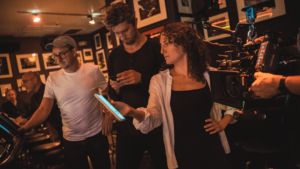The need for online events has created many more opportunities for event creators. As events moved online, event-goers also started enjoying a new kind of experience. That’s why many creators decided to continue hosting online and hybrid events even as restrictions eased.
But what are hybrid events exactly? They’re special gatherings that let guests participate either online or in-person. These events work to increase event attendance while letting guests choose how they’d like to attend. Whether attendees are there in the flesh or watching from a computer, they’re essentially watching the same event — similar to sporting events that you can either attend live or watch on TV.
There are two types of hybrid events:
- External hybrid events like concerts, conferences, workshops, trade shows, and more. These are ideal for businesses looking to entertain and/or market products to audiences.
- Internal hybrid events, which are for gathering within a company or group of people. Think team meetings and town halls — but where participants can attend in-person or online.
Hybrid events can differ a lot depending on the occasion, but they always involve a presentation for both live and remote audiences.
While setting up a hybrid event might sound high-tech and complicated, they’re actually very simple thanks to Eventbrite. Eventbrite lets you stream with a video-sharing platform like Google Meet, Zoom, or Vimeo Live. From there, all you need is a video camera and your live event can be shared with all your online attendees.
Why you should consider a hybrid event
If you’ve only hosted in-person events in the past, there are many reasons why expanding to include an online element is a good idea. What do hybrid events mean for creators? As mentioned before, they give guests an alternative method to watch your event. Should they opt for online viewing, these guests can see your event without major travel expenses or commitments.
Offering a hybrid event also lets more people attend. This can increase revenue, user engagement, and sponsorship opportunities compared to only hosting a live event.
Better still, hybrid events allow part of your event to go on as planned, without having to postpone or cancel it entirely if something arises — whether that’s bad weather or changes to health guidelines. If you’ve planned a hybrid event, you can simply switch the event to online-only so that guests hoping to attend live can still watch it.
Read on for our top tips for setting up hybrid events.
Learn more about your online audience
Live events are easy for guests — just schedule a place and time and they’ll show up. For an online event, things aren’t quite as simple. You need to make choices about how the event will be streamed and set up, based on what your audience wants. This will help guarantee the most online ticket sales possible.
You may be using many different social media platforms, video hosting sites, apps, and streaming sites where fans connect with your brand. The question is: How can they all watch your event online? While you’re still planning your event, you can reach out to your online customers through surveys, polls, and other feedback systems to help you decide on which platforms you should use to stream your event.
Once you’ve made these decisions, give your followers plenty of time to adjust to watching your online event. Not every follower will find streaming easy, so consider posting streaming instructions a few days before you go live.
Make your online events enjoyable for attendees
When it comes to streaming events online, presentation is crucial, as you want viewers to enjoy what they’re watching on their computers or other devices. Unless you’re hosting workshops, seminars, or team meetings, the bare minimum simply won’t cut it. Presentations, concerts, and other events with multiple focal points call for a dynamic camera setup, rather than a single camera feed.
With multiple camera angles, you can choose the feed on the spot when there’s a speaker, subject, or screen that you want viewers to pay attention to. As you do this, your online viewers will be able to follow your event smoothly without missing the important details. This is sure to encourage attendees to register interest in more online events in the future.
Another thing to consider is providing lighting for your event, especially if the venue or room lighting is not enough. To discover more tips, take a look at our Live Event Production Checklist, which covers everything you need to know about planning a great production. You can also explore more resources for specific hybrid events.
Consider extra incentives for in-person event tickets
Consumers will see the appeal in an online-viewing format right off the bat. Apart from the time and money it takes to travel to a live event, a higher cost for an in-person ticket might also encourage them to opt for an online ticket. There’s no silver-bullet answer to how much you should charge for in-person and livestream tickets, but due to the limited availability of in-person tickets, companies tend to price them significantly higher. These things can often affect in-person attendance, which you should count on to help make the most of your event revenue.
Think about creating incentives to make an in-person experience more special and enticing. Perks for in-person attendees could come in the form of exclusive merchandise, meet-and-greets, and coupons or other exclusive deals. Such bonuses can be used to help increase live attendance — making your events more exciting for online viewers too.
Be sure the online experience is on par with the live experience
Online and virtual attendees are watching the same event, but it takes different strategies to keep each audience type engaged. Make sure that your online event isn’t planned as an afterthought so that virtual attendees feel included in the action. Of course, an online event won’t have the ambiance of a live event, but you should still make sure the experience is top-notch for attendees.
When streaming an event, it’s essential to offer good audio and video, and have someone ready to troubleshoot in case anything goes wrong. Fortunately, many streaming platforms like Zoom allow you to connect with viewers who are watching your event online in case they face any problems. This lets you resolve any audio or video issues quickly so your viewers can enjoy the event to the same degree as your live attendees.
The future of hybrid events is looking very bright. Setting up this kind of event calls for some major changes, but it also leads to huge improvements to revenue and attendance. Let Eventbrite show you how you can use live event technology to help create an engaging hybrid event.





